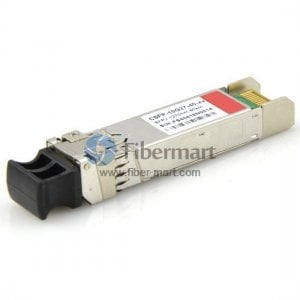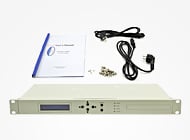
OADM (Optical Add-Drop Multiplexer)
What's OADM? What is add drop oadm?
| The evolution of single wavelength point-to-point transmission lines to wavelength division multiplexed optical networks has introduced a demand for wavelength selective optical add-drop multiplexers (OADMs) to seprarte/route different wavelength channels. OADM is a device used in wavelength-division multiplexing systems for multiplexing and routing different channels of light into or out of a singlemode fiber (SMF). This is a type of optical node, which is generally used for the construction of optical telecommunications networks. "Add" refers to the capability of the device to add one or more new wavelength channels to an existing multi-wavelength WDM signal while "drop" refers to drop or remove one or more channels, passing those signals to another network path. An OADM may be considered to be a specific type of optical cross-connect. The main implementation technologies of OADM are WDM (Wavelength Division Multiplexing), O-CDMA (Optical Code Division Multiple Access) and OTDM (Optical Time Division Multiplexing). OADM is the key component of AON(All-Optical Network). |
Structure and Working Principle of OADM
A traditional OADM consists of three parts: an optical demultiplexer, an optical multiplexer and between them a method of reconfiguring the paths between the optical demultiplexer, the optical multiplexer and a set of ports for adding and dropping signals. The MUX multiplexes the wavelength channels that are to continue on from DEMUX ports with those from the add ports, onto a single output fiber, while the DEMUX separates wavelengths in an input fiber onto ports. The reconfiguration can be achieved by a fiber patch panel or by optical switches which direct the wavelengths to the MUX or to drop ports. All the light paths that directly pass an OADM are termed cut-through lightpaths, while those that are added or dropped at the OADM node are termed added/dropped lightpaths.
OADM working process as follows: WDM signals from line contains N wavelength channel, enter the OADM "Main Input" side, depending on your business needs, from N wavelength channel, selectively from the road-side (Drop) required by the output wavelength channel, accordingly from the road-end (Add) enter the desired wavelength channel. Regardless of other local wavelength channel directly through the OADM, and routing wavelength channels multiplexed together, from the output terminals of the circuit of OADM (Main Output) output. The following picture shows the basic operation of an OADM.

Physically, there are several ways to realize an OADM. There are a variety of demultiplexer and multiplexer technologies including TFF(thin film filter), FBG(fiber bragg grating) with optical circulators, free space grating devices and integrated planar arrayed waveguide gratings (Optical add-drop multiplexer, using a fiber Bragg grating and two circulators as the following picture). The switching or reconfiguration functions range from the manual fiber patch panel to a variety of switching technologies including microelectromechanical systems (MEMS), liquid crystal and thermo-optic switches in planar waveguide circuits.

Array waveguide FBG can create different types of OADM structures. In addition, it can use all fiber optic technology to construct all-optical OADM. What should be pay attention is that no matter what kind of OADM, the basic requirement is the same, such as small loss, higher isolation degree between channel, polarization insensitive to changing temperature, tolerant signal source drift and jitter within a certain range. Also in the process to be able to guarantee basic consistent between the various channels of the transmission of power. Last, strive to keep simple and convenient that can achieve high performance ratio.
Tips: Although both have add/drop functionality, OADMs are distinct from add-drop multiplexers. The former function in the photonic domain under wavelength-division multiplexing, while the latter are implicitly considered to function in the traditional SONET/SDH networks.
Types of OADM
There are two main types of OADM that can be used in WDM optical networks — Fixed OADM (FOADM) and Reconfigurable OADM (ROADM). An OADM with remotely reconfigurable optical switches (for example 1×2) in the middle stage is called a reconfigurable OADM (ROADM). Ones without this feature are known as fixed OADMs. Fixed OAMDs are used to drop or add data singles on dedicated WDM channels, and reconfigurable OADMs have the ability to electronically alter the selected channel routing through the optical network. While the term OADM applies to both types, it is often used interchangeably with ROADM.
Fixed Optical Add-Drop Multiplexers (FOADM)
Fixed Optical Add-Drop Multiplexers (FOADMs) were originally developed to improve the delivery of "express" traffic through networks, without requiring expensive OEO regeneration. FOADMs use fixed filters that add/drop a selected wavelength "band" and pass the rest of the wavelengths through the node. Static wavelength-filtering technology eliminates the cost and attenuation to demultiplex all DWDM signals in a signal path. The solution is called FOADM because the wavelength(s) added and dropped are fixed at the time of add/drop filter installation on the optical path through a node. No additional filters can be added without interrupting express wavelengths traveling through the node.
Reconfigurable Optical Add-Drop Multiplexers (ROADM)
Reconfigurable Optical Add Drop Multiplexers (ROADMs) were developed to provide flexibility in rerouting optical streams, bypassing faulty connections, allowing minimal service disruption and the ability to adapt or upgrade the optical network to different WDM technologies.
The ROADMs reconfiguration functions are achieved using various switching technologies including liquid crystal, thermo optic , micro electromechanical systems (MEMS)and tunable optical filter technology.ROADM were implemented in many ways such as Fixed point ROADM. It is similar to fixed point OADMs though and has tunable filters. Fixed point ROADMs employ wavelength blocker (WB) devices with high insertion loss and integrated photonic light wave circuit (PLC). Wavelength selective ROADMs use flexible filters, wavelength selective switches (WSS) and optical cross-connects. Study illustrated that ROADM are a significant network element in the next generation all optical networks for the applications in both long-haul and metro systems. It further enhances the communication networks efficiency as well as dynamic connectivity in the optical networks with added network survivability. It uses field-proven technology and components, contributing a reliable and low cost solution due to switching.
ROADM networks are accompanied with fundamental components as Amplifiers (Pre-Amp & Post-Amp), Dispersion Compensation unit, Transponders, Optical Service Channel, Optical Power supervising and ROADM Subsystem. Basically ROADM can be classified as of different types as Wavelength Selective Switches (WSS), Optical Cross-Connects (OXC), in the broadest sense as Type I/II ROADM and Multidegree-ROADM.
.png)
FOADM vs ROADM
FOADMs are based on simple static fibers that permit add/drop of predefined wavelengths. These systems are fully integrated and manageable and provide a fine balance of features and cost. ROADMs add the ability to remotely switch traffic from a WDM system at the wavelength layer. While more expensive than FOADMs, ROADMs are used in application where traffic patterns are not fully known or change frequently.
In addition, according to the multiplexing wavelengths, OADMs can be divided into two types which are CWDM OADM and DWDM OADM. CWDM OADM is designed for the CWDM passive optical systems. It can multiplex/demultiplex or add/drop wavelengths from multiple fibers onto one optical fiber. And DWDM OADM is designed to optical add/drop one multiple DWDM channels into one or two fibers. DWDM Optical Add & Drop is the ideal solution for the increasing bandwidth demand on enterprise and metro access networks. ESCON, ATM, Fiber Channel, Gigabit Ethernet are supported simultaneously, without disturbing each other.
Functions and Applications of OADM
Functions
General the OADM node can be represented by a four-port models, including three basic functions: Drop required wavelength signal, Add rumored signal to other wavelengths pass through unaffected. Additionally, there are different functions of different types of OADM. For example, FWDM only have one or more fixed wavelength, the node's routing is determined but is not flexibility, but in reliable performance and time saving, while ROADM is more flexibility and also cost more expensive.
Applications

1. MAN (Metropolitan Area Network)
OADM has a business in the middle of choice. Of course, the main battlefield of application is MAN (metropolitan area network). That can be working flexibility, easy to upgrade and amplify the network. An Ideal multi-services transport platform in MAN application.
2. OXC (Optical Cross Connection)
OADM allows different optical network of different wavelength multiplexing signal at different locations. Propsed equipment allow different network connect dynamic. On-demand wavelength resources, a wider range of network interconnection. OADM and OXC only need to download the information in the nodes to send a person to handle the equipment, including ATM switchboard, SDH switchboard, IP router etc., which greatly improve the efficiency of the node to process information.
Fiber-Mart OADM Solution
Fiber-Mart offers various CWDM OADM and DWDM OADM configurations to fit your CWDM or DWDM network system.
CWDM OADM
Fiber-Mart CWDM OADM modules are available in Field Module ABS Plastic Box, 19" Rack Mount Chassis and LGX Metal Cassette Box packages. The available configuration is 1, 2, 4, 8, and 16 channels. All the modules provide excellent optical performance and high reliability to ease of fiber handling and power saving solution.
Additionally, the OADM connectors are interfaced to the color-matching CWDM GBIC modules on the equipment side. All the transceiver modules have the same size. Take Cisco for example, the Cisco CWDM 2-slot chassis allows you to rack mount up to two CWDM OADMs in a single rack unit. There are four different types of CWDM OADMs.
1. Dual Single-Channel OADM
Dual single-channel OADM allows you to add/drop two channels of the same wavelength into the two directions of an optical ring. The other wavelengths are passed through the OADM. Dual fiber is used for both the network and the CWDM GBIC connections. Eight versions of this OADM are available, one for each wavelength of light. The dual single-channel OADMs are color coded and match the color coding of the CWDM.
2. 4-Channel OADM
4-Channel OADM (CWDM-MUX-4=) allows you to add/drop four channels (with different wavelengths) into one direction of an optical ring. The other wavelengths are passed through the OADM. Dual fiber is used for both the network and the GBIC connections. The four wavelengths are set to 1470 nm, 1510 nm, 1550 nm, and 1590 nm.
3. 8-Channel MUX/DEMUX
8-Channel CWDM MUX/DEMUX (CWDM-MUX-8=) allows you to multiplex/demultiplex eight separate channels into one pair of fiber. Dual fiber is used for both the network and the GBIC connections. The eight available wavelengths are 1470 nm, 1490 nm, 1510 nm, 15300 nm, 1550 nm, 1570 nm, 1590 nm, and 1610 nm.
4. Single Fiber 4-Channel MUX/DEMUX
Single fiber 4-channel CWDM MUX/DEMUX (CWDM-MUX-4-SFx=) allows you to multiplex/demultiplex four separate channels into one strand of fiber. Dual fiber is used for the connections to the GBICs and single fiber is used for the network connections. The two models (CWDM-MUX-4-SF1= and CWDM-MUX-4-SF2=) must be used together to create a four-channel single-fiber point-to-point link. This module uses the same CWDM GBICs as all of the other CWDM.
Tips: CWDM GBIC is a hot-swappable input/output device that links your switching module to the CWDM passive optical system using a pair of single-mode fiber optic cables. You can connect your multiplexed/demultiplexed wavelengths and added/dropped channels to CWDM GBICs that are installed in your system.
DWDM OADM
Fiber-Mart DWDM OADM modules are available in standalone 19" Rack Mount, LGX module and Field module packing. Add/drop channels are interfaced to any of Fiber-Mart DWDM transceivers on the equipment side, and we also provide optional port configurations, such as Monitor Port, 1310nm passband port and Express port according to customer request. Com Port Connector and Com Port Connector are also optional.
Features of CWDM/DWDM OADM
Optical drop/pass and drop/insert of single CWDM/DWDM channel for pointto- point, ring- or bus configuration Entirely passive device,no power supply needed Low-cost transceivers applicable, existing equipment can still be used Fully transparent to all data rates and protocols Up to10 Gbit/s per channel Compliant to ITU-T CWDM/DWDM standards
-consulting for technical supports or relevent product buying guide
Email for [email protected]

















No comments have been posted yet.